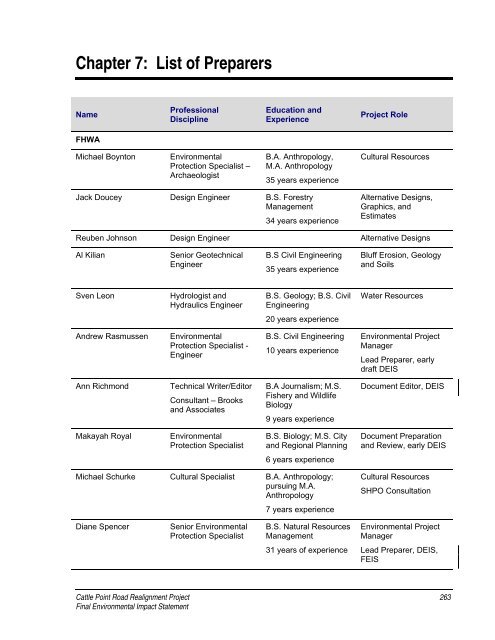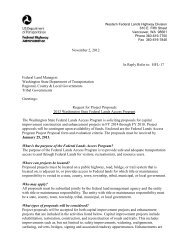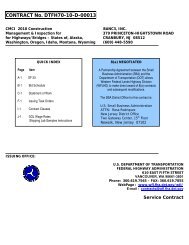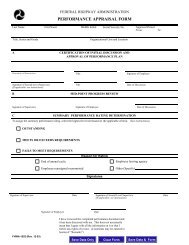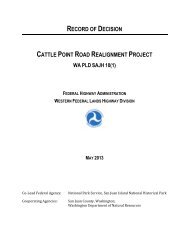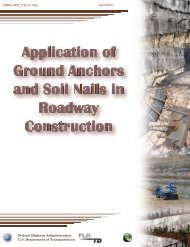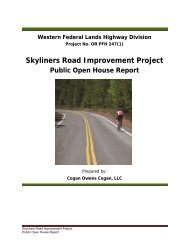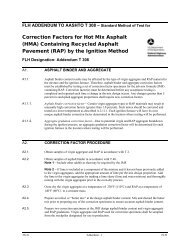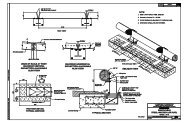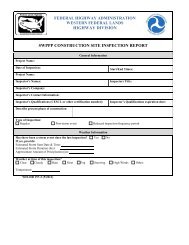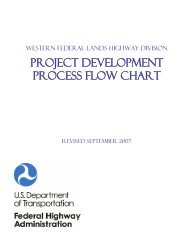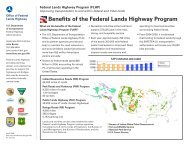Chapter 7: List of Preparers - Western Federal Lands Highway ...
Chapter 7: List of Preparers - Western Federal Lands Highway ...
Chapter 7: List of Preparers - Western Federal Lands Highway ...
Create successful ePaper yourself
Turn your PDF publications into a flip-book with our unique Google optimized e-Paper software.
<strong>Chapter</strong> 7: <strong>List</strong> <strong>of</strong> <strong>Preparers</strong><br />
Name<br />
FHWA<br />
Michael Boynton<br />
Pr<strong>of</strong>essional<br />
Discipline<br />
Environmental<br />
Protection Specialist –<br />
Archaeologist<br />
Education and<br />
Experience<br />
B.A. Anthropology,<br />
M.A. Anthropology<br />
35 years experience<br />
Jack Doucey Design Engineer B.S. Forestry<br />
Management<br />
34 years experience<br />
Project Role<br />
Cultural Resources<br />
Alternative Designs,<br />
Graphics, and<br />
Estimates<br />
Reuben Johnson Design Engineer Alternative Designs<br />
Al Kilian Senior Geotechnical<br />
Engineer<br />
Sven Leon Hydrologist and<br />
Hydraulics Engineer<br />
Andrew Rasmussen Environmental<br />
Protection Specialist -<br />
Engineer<br />
Ann Richmond Technical Writer/Editor<br />
Consultant – Brooks<br />
and Associates<br />
Makayah Royal Environmental<br />
Protection Specialist<br />
B.S Civil Engineering<br />
35 years experience<br />
B.S. Geology; B.S. Civil<br />
Engineering<br />
20 years experience<br />
B.S. Civil Engineering<br />
10 years experience<br />
B.A Journalism; M.S.<br />
Fishery and Wildlife<br />
Biology<br />
9 years experience<br />
B.S. Biology; M.S. City<br />
and Regional Planning<br />
6 years experience<br />
Michael Schurke Cultural Specialist B.A. Anthropology;<br />
pursuing M.A.<br />
Anthropology<br />
7 years experience<br />
Diane Spencer Senior Environmental<br />
Protection Specialist<br />
B.S. Natural Resources<br />
Management<br />
31 years <strong>of</strong> experience<br />
Bluff Erosion, Geology<br />
and Soils<br />
Water Resources<br />
Environmental Project<br />
Manager<br />
Lead Preparer, early<br />
draft DEIS<br />
Document Editor, DEIS<br />
Document Preparation<br />
and Review, early DEIS<br />
Cultural Resources<br />
SHPO Consultation<br />
Environmental Project<br />
Manager<br />
Lead Preparer, DEIS,<br />
FEIS<br />
Cattle Point Road Realignment Project 263<br />
Final Environmental Impact Statement
NPS<br />
Peter Dederich Superintendent, San<br />
Juan Island National<br />
Historical Park<br />
(SJINHP)<br />
Bill Gleason Chief <strong>of</strong> Resource<br />
Management, SJINHP<br />
Rose Rumball-Petre Environmental<br />
Protection Specialist,<br />
Pacific West Region<br />
Cheryl Teague <strong>Lands</strong>cape Architect,<br />
Pacific West Region<br />
San Juan County<br />
NPS Park Policy<br />
NPS Compliance<br />
NPS Compliance<br />
NPS Compliance<br />
Louis J. Haff Consultant Engineer Alternative Designs and<br />
County Resources<br />
Russ Harvey Operations Manager Road Use Information<br />
US Forest Service<br />
Scott Riley Botanist, Region 6<br />
Restoration Services<br />
Team<br />
David Steinfeld Soil Scientist, Region 6<br />
Restoration Services<br />
Team<br />
Washington State Department <strong>of</strong> Natural Resources (DNR)<br />
Preliminary<br />
Revegetation Plan<br />
Preliminary<br />
Revegetation Plan<br />
Christ Thomsen Public Use Manager DNR Issues<br />
Kathy Gunther Natural Areas Steward NRCA Issues<br />
Consultants<br />
Vaughn Anderson Consultant Project<br />
Manager, Engineer<br />
DJ&A PC<br />
Mary Hamilton Consultant,<br />
Environmental<br />
Specialist<br />
Widener and<br />
Associates<br />
Ross Widener Consultant Project<br />
Manager<br />
Widener and<br />
Associates<br />
Masters <strong>of</strong> Applied<br />
Sciences<br />
Alternative Design<br />
Engineering and<br />
Graphics<br />
Vegetation and Wildlife<br />
Resources<br />
Scoping Document,<br />
Resource Reports,<br />
Public Involvement,<br />
Preparer early DEIS<br />
264 Cattle Point Road Realignment Project<br />
Final Environmental Impact Statement
REVIEWERS:<br />
FHWA/WFLHD<br />
Victoria Brinkly, <strong>Highway</strong> Safety Engineer<br />
Betty Chon, Project Manager<br />
Jennifer Corwin, Environmental Specialist<br />
Dave L<strong>of</strong>gren, Geotechnical Engineer<br />
Jody Marshall, Environmental Senior Technical Specialist<br />
Rayann Speakman, Legal Counsel<br />
Malcolm Ulrich, Geotechnical Engineer<br />
NPS<br />
Chris Davis, Resource Management Specialist, San Juan Island National Historical Park<br />
Keith Dunbar, Team Leader for Planning and Partnerships, Pacific West Region<br />
Dave Kruse, Former Transportation Program Manager, Pacific West Region<br />
Alan Schmierer, Regional Environmental Coordinator, Pacific West Region<br />
Lee Taylor, Superintendent, San Juan Island National Historical Park<br />
DNR<br />
Alison Hitchcock, NW Region Natural Areas Manager<br />
Stan Kurowski, NW Region Operations Manager<br />
Deborah Nemens, Natural Areas Assistant Ecologist - Westside<br />
Curt Pavola, Natural Areas Program Manager<br />
Pene Speaks, Assistant Division Manager<br />
David Wilderman, Natural Areas Ecologist - Westside<br />
San Juan County<br />
Jon Shannon, Public Works Director<br />
John Van Lund, County Engineer<br />
Shannon Wilbur, Transportation Planning Engineer<br />
Cattle Point Road Realignment Project 265<br />
Final Environmental Impact Statement
266 Cattle Point Road Realignment Project<br />
Final Environmental Impact Statement
<strong>List</strong> <strong>of</strong> Acronyms and Abbreviations<br />
AASHTO American Association <strong>of</strong> State <strong>Highway</strong> and Transportation Officials<br />
ACHP Advisory Council on Historic Preservation<br />
APE Area <strong>of</strong> Potential Effects<br />
BA Biological Assessment (under Section 7 <strong>of</strong> the Endangered Species<br />
Act an assessment <strong>of</strong> the adverse impacts <strong>of</strong> a proposed action on a<br />
species listed by the USFWS)<br />
BGEPA Bald and Golden Eagle Protection Act<br />
BLM Bureau <strong>of</strong> Land Management<br />
BMP Best Management Practice<br />
BO Biological Opinion (a determination, under Section 7 <strong>of</strong> the<br />
Endangered Species Act) <strong>of</strong> the effects <strong>of</strong> a proposed action on a<br />
species listed by the USFWS)<br />
CAA Clean Air Act<br />
CFR Code <strong>of</strong> <strong>Federal</strong> Regulations<br />
CEQ Council on Environmental Quality<br />
CSJWD Cape San Juan Water District<br />
CWA Clean Water Act<br />
CZMA Coastal Zone Management Area<br />
CZMP Coastal Zone Management Programs<br />
CLI Cultural <strong>Lands</strong>capes Inventory<br />
DBA A-weighted decibels<br />
DEIS Draft Environmental Impact Statement<br />
DNR Washington State Department <strong>of</strong> Natural Resources<br />
DO Director’s Order<br />
DOH Washington State Department <strong>of</strong> Health<br />
DOT Department <strong>of</strong> Transportation<br />
ECM Environmental Compliance Memorandum<br />
EFH Essential Fish Habitat<br />
Cattle Point Road Realignment Project 267<br />
Final Environmental Impact Statement
EIS Environmental Impact Statement<br />
EO Executive Order<br />
EPA (United States) Environmental Protection Agency<br />
ESA Endangered Species Act<br />
ESU Evolutionary Significant Unit<br />
FEIS Final Environmental Impact Statement<br />
FHWA <strong>Federal</strong> <strong>Highway</strong> Administration<br />
FLH <strong>Federal</strong> <strong>Lands</strong> <strong>Highway</strong><br />
GMP General Management Plan<br />
HAP Hazardous Air Pollutant<br />
MBTA Migratory Bird Treaty Act<br />
MMPA Marine Mammal Protection Act<br />
MP Milepost<br />
MPH Miles Per Hour<br />
NAAQS National Ambient Air Quality Standards<br />
NAGPRA Native American Graves Protection and Repatriation Act<br />
NEPA National Environmental Policy Act<br />
NHP National Historical Park<br />
NHL National Historic Landmark<br />
NHPA National Historic Preservation Act<br />
NMFS National Marine Fisheries Service<br />
NPS National Park Service<br />
NPDES National Pollutant Discharge Elimination System<br />
NRHP National Register <strong>of</strong> Historic Places<br />
NRCA Natural Resources Conservation Area<br />
NRCS Natural Resources Conservation Service<br />
NOA Notice <strong>of</strong> Availability<br />
NOAA National Oceanic and Atmospheric Administration<br />
OAHP Office <strong>of</strong> Archaeology and Historic Preservation<br />
268 Cattle Point Road Realignment Project<br />
Final Environmental Impact Statement
RCRA Resource Conservation and Recovery Act <strong>of</strong> 1976<br />
RCW Revised Code <strong>of</strong> Washington<br />
RPP Recreation and Public Purpose<br />
SEA Shorelands and Environmental Assistance Program<br />
SAFETEA-LU The Safe, Accountable, Flexible, Efficient Transportation Equity Act:<br />
A Legacy for Users<br />
SEPA State Environmental Policy Act<br />
SHPO State Historic Preservation Office or Officer<br />
SPCC<br />
SMA<br />
Spill Prevention, Control, and Countermeasure<br />
Washington State Shoreline Management Act<br />
SWPPP Storm Water Pollution Prevention Plan<br />
THPO Tribal Historic Preservation Office<br />
USACE United States Army Corps <strong>of</strong> Engineers<br />
USC United States Code<br />
USFWS United States Fish and Wildlife Service<br />
USGS United States Geological Survey<br />
WA Washington<br />
WAC Washington Administrative Code<br />
WDFW Washington Department <strong>of</strong> Fish and Wildlife<br />
WDOE Washington State Department <strong>of</strong> Ecology<br />
WFLHD <strong>Western</strong> <strong>Federal</strong> <strong>Lands</strong> <strong>Highway</strong> Division<br />
WNHP Washington Natural Heritage Program<br />
WSDOT Washington State Department <strong>of</strong> Transportation<br />
Cattle Point Road Realignment Project 269<br />
Final Environmental Impact Statement
270 Cattle Point Road Realignment Project<br />
Final Environmental Impact Statement
Glossary<br />
Technical Terms Used in This Document<br />
Affected environment: The existing physical, biological, cultural, and social environment in<br />
the project area and vicinity. It describes the existing conditions <strong>of</strong> resources that may be<br />
affected by the project alternatives if they were implemented.<br />
Alternatives: Sets <strong>of</strong> management elements that represent a range <strong>of</strong> options for how or<br />
whether to proceed with a proposed action. An environmental document analyzes the potential<br />
environmental impacts <strong>of</strong> the range <strong>of</strong> alternatives, as required under the National<br />
Environmental Policy Act (NEPA).<br />
Anadromous: Fish that are born in fresh water, spend a portion <strong>of</strong> their lives in the ocean, then<br />
return to fresh water to spawn.<br />
Area <strong>of</strong> permanent disturbance: The area permanently covered by pavement.<br />
Area <strong>of</strong> potential effect: The geographic area or areas within which an undertaking may<br />
directly or indirectly cause changes in the character or use <strong>of</strong> historic properties.<br />
Area <strong>of</strong> temporary disturbance: The area <strong>of</strong> ground impacted by construction activities that<br />
would be restored to preconstruction conditions following completion <strong>of</strong> the project.<br />
Best Management Practices (BMPs): Effective, practical, structural and nonstructural<br />
methods which prevent or reduce soil erosion or the movement <strong>of</strong> sediment.<br />
CEQ Regulations: Congress established the Council on Environmental Quality (CEQ) as part<br />
<strong>of</strong> the National Environmental Policy Act <strong>of</strong> 1969 (NEPA) to oversee federal agency<br />
implementation <strong>of</strong> the environmental impact assessment process. CEQ regulations provide<br />
guidance for federal agency compliance with NEPA.<br />
Cooperating agency: An agency working collaboratively with the lead agency in completion<br />
<strong>of</strong> the NEPA process for the project.<br />
County: Referring to San Juan County.<br />
Cumulative impact: The impact on the environment which results from the incremental<br />
impact <strong>of</strong> the action when added to other past, present, and reasonably foreseeable future<br />
actions.<br />
Cultural landscape: Defined by the World Heritage Committee as a distinct geographical area<br />
or properties uniquely "representing the combined work <strong>of</strong> nature and <strong>of</strong> man." A historically<br />
significant landscape within the National Park System<br />
Cut: Excavation required to lower the natural ground line to the desired road pr<strong>of</strong>ile.<br />
Cut slope: The upslope face <strong>of</strong> an excavated bank sloping up from the road bed.<br />
Decibel: A unit <strong>of</strong> measure for sound intensity.<br />
Direct effects or impacts: Effects caused by an action and occurring at the same time and<br />
place.<br />
Cattle Point Road Realignment Project 271<br />
Final Environmental Impact Statement
Earthwork: The earth which must be moved from one place to another during road<br />
construction for activities such as cuts, fills, and tunnel construction.<br />
Environmental Impact Statement (EIS): A document required <strong>of</strong> federal agencies by the<br />
National Environmental Policy Act for major projects significantly affecting the environment.<br />
A tool used for decision making, describing the positive and negative effects <strong>of</strong> the undertaking<br />
and alternative actions.<br />
Environmentally preferable alternative: The alternative that will promote the national<br />
environmental policy in Section 101 <strong>of</strong> NEPA. Ordinarily, this means the alternative that<br />
causes the least damage to the biological and physical environment; it also means the alternative<br />
which best protects, preserves, and enhances historic, cultural, and natural resources.<br />
Estimated construction cost: Estimated total cost for all aspects <strong>of</strong> project construction.<br />
Fill: A section <strong>of</strong> roadway where earth must be imported and placed in construction.<br />
Fill slope: The face <strong>of</strong> a down slope bank <strong>of</strong> a roadway.<br />
Floodplain: Land area subject to periodic flooding from a contiguous body <strong>of</strong> water.<br />
Floodplains are delineated by the expected frequency <strong>of</strong> flooding.<br />
Grade:. The slope <strong>of</strong> the roadway surface. Grade is expressed as the change in elevation per<br />
100 feet <strong>of</strong> horizontal distance.<br />
Guardrail: A safety feature consisting <strong>of</strong> a rail and post system that is intended to reduce the<br />
chances <strong>of</strong> cars traveling <strong>of</strong>f the road.<br />
Historic property: Under NHPA and NEPA/CEQ a district, site, building, structure, or object<br />
that is included in or eligible for listing in the National Register <strong>of</strong> Historic Places, and includes<br />
resources to which American Indians attach cultural and religious significance.<br />
Invasive species: A non-native species <strong>of</strong> plant or wildlife that employs habits that allow it to<br />
take over the habitat to displace native species.<br />
Irretrievable Commitments <strong>of</strong> Resources: Actions that result in the loss <strong>of</strong> resources that,<br />
once gone, cannot be replaced.<br />
Irreversible Commitments <strong>of</strong> Resources: Actions that result in the loss <strong>of</strong> resources that<br />
cannot be reversed or restored to their original condition.<br />
Lead agency: The agency preparing or having taken primary responsibility in completion <strong>of</strong><br />
the NEPA process for a project.<br />
Mitigation: Mitigation is the attempt to <strong>of</strong>fset potential adverse effects <strong>of</strong> human activity on<br />
the environment by actions used to avoid, minimize, rectify, eliminate, or compensate.<br />
National Environmental Policy Act: The National Environmental Policy Act (NEPA)<br />
requires that federal agencies integrate environmental values into their decision-making<br />
processes by considering the environmental impacts <strong>of</strong> their proposed actions and reasonable<br />
alternatives to those actions. NEPA requires that federal agencies follow procedural steps when<br />
making decisions that may have an effect on the human environment.<br />
No action alternative: The alternative that proposed to continue current management actions<br />
and direction. “No Action” means the proposed activity would not take place.<br />
272 Cattle Point Road Realignment Project<br />
Final Environmental Impact Statement
Non-native or exotic species: Organisms that are not indigenous to the ecosystem to which<br />
they were introduced and which are capable <strong>of</strong> surviving and reproducing without human<br />
intervention.<br />
Organic Act (NPS) 1916: The National Park Service Organic Act established the National<br />
Park Service to “promote and regulate the use <strong>of</strong> the parks . . .” and defined their purpose “to<br />
conserve the scenery and the natural and historic objects and the wildlife therein and to provide<br />
for the enjoyment <strong>of</strong> the same in such manner and by such means as will leave them unimpaired<br />
for the enjoyment <strong>of</strong> future generations.”<br />
Park: Referring to the San Juan Island National Historical Park.<br />
Predicted life span: The length <strong>of</strong> time a structure is expected to last based on average<br />
conditions and durability <strong>of</strong> material components.<br />
Preferred alternative: The alternative which the cooperating agencies believe would fulfill<br />
their mission and responsibilities, including the purpose and need for the project and other<br />
factors.<br />
Project team or team: The interdisciplinary team consisting <strong>of</strong> specialists from several fields<br />
combining skills and resources to conduct the NEPA analysis for the project.<br />
Public comment process: The role <strong>of</strong> the public in the NEPA process, particularly during<br />
scoping, in providing input on what issues should be addressed in the environmental document<br />
and in commenting on the findings in an agency's NEPA documents.<br />
After issuance <strong>of</strong> a draft EIS, a Notice <strong>of</strong> Availability is published in the <strong>Federal</strong> Register to<br />
begin the public comment period <strong>of</strong> at least 45 days, during which time the public may comment<br />
on the NEPA document content and project development process.<br />
Pullout: A widened section <strong>of</strong> roadway that allows vehicles to pull <strong>of</strong>f the road for viewing,<br />
access to terrain or emergencies. Pullouts may be formal (paved or graveled) or user-designated<br />
(created by visitor use over time). Also called a turn out.<br />
Purpose and need: The underlying purpose and need to which the agency is responding in<br />
proposing the alternatives. The purpose and need states the problems <strong>of</strong> the transportation<br />
facility and the goal for the facility.<br />
Retaining wall: A wall built to stabilize hillsides, control erosion or reduce the grade <strong>of</strong> a road<br />
or the length or height <strong>of</strong> the cut or fill slope.<br />
Road: In reference to the Cattle Point Road.<br />
Scoping: Initial project research effort that includes coordination efforts with government<br />
agencies, identification <strong>of</strong> interested parties, initializing contacts, identifying potential concerns,<br />
preliminary assessment <strong>of</strong> area resources, and investigation <strong>of</strong> potential solutions.<br />
Secondary (or indirect) effects: Effects caused by an action but which are removed by greater<br />
time or distance from the original action, although still reasonably foreseeable.<br />
Section 7 consultation: Section 7 <strong>of</strong> the Endangered Species Act requires federal agencies,<br />
when proposing a federal action, to obtain a species list for the project area from, and to consult<br />
with, the U.S. Fish and Wildlife Service (USFWS) regarding potential impacts from the<br />
proposed action.<br />
Cattle Point Road Realignment Project 273<br />
Final Environmental Impact Statement
Short-term use vs. Long-term productivity: A review <strong>of</strong> the balance or trade-<strong>of</strong>fs between<br />
short-term uses and long-term productivity <strong>of</strong> resources within the project area.<br />
Sight distance: The length <strong>of</strong> roadway ahead continuously visible to the driver. The three<br />
types <strong>of</strong> sight distance common in roadway design are intersection sight distance, stopping sight<br />
distance, and passing sight distance.<br />
Special vehicles: Two and three-wheeled mopeds or “scoot cars” that frequently utilize island<br />
roadways.<br />
Take: To harass, harm, pursue, hunt, shoot, wound, kill, trap, capture, or collect.<br />
Threatened or endangered species: Species protected under the Endangered Species Act <strong>of</strong><br />
1973 (ESA) or by Washington Administrative Code (WAC). A threatened species is a native<br />
species that is at risk <strong>of</strong> becoming endangered in the near future. A threatened species may have<br />
a declining population or be exceptionally rare. An endangered species is a native species that<br />
faces a significant risk <strong>of</strong> extinction in the near future throughout all or a significant portion <strong>of</strong><br />
its range.<br />
Unavoidable adverse impacts: Moderate to major impacts that cannot be fully mitigated or<br />
avoided<br />
U.S. Fish and Wildlife Service (USFWS): The federal agency responsible for conserving,<br />
protecting, and enhancing fish, wildlife, and plants and their habitats; includes regulatory<br />
authority for the Endangered Species Act.<br />
Visitor experience: The perceptions, feelings, reactions, and activities <strong>of</strong> park visitors in<br />
relationship to the surrounding environment<br />
Visitor use: The types <strong>of</strong> recreation activities engaged in by visitors, including the type <strong>of</strong><br />
activity, visitor behavior, timing, and distribution <strong>of</strong> use.<br />
Wetland: An area inundated or saturated with surface or ground water at a frequency and<br />
duration sufficient to support, and that under normal circumstances does support, a prevalence<br />
<strong>of</strong> vegetation typically adapted for life in saturated soil conditions.<br />
274 Cattle Point Road Realignment Project<br />
Final Environmental Impact Statement
Bibliography<br />
AASHTO. 2006. Roadside Design Guide, 3 rd Edition 2006, with updated <strong>Chapter</strong> 6. American<br />
Association <strong>of</strong> State <strong>Highway</strong> and Transportation Officials.<br />
CSJWD. 1998. Wellhead Protection Plan. Cape San Juan Water District, San Juan County,<br />
Washington, April 15, 1998.<br />
DNR. 1992. NRCA Statewide Management Plan, September. Washington State Department <strong>of</strong><br />
Natural Resources.<br />
DNR. 2004. Strategic Plan for the Department <strong>of</strong> Natural Resources 05-07 Biennium.<br />
Washington State Department <strong>of</strong> Natural Resources, April 29, 2004.<br />
DNR. 2006. Surveys for Island Marble Butterfly (Euchloe ausonides insulanus) in San Juan<br />
County, Washington.<br />
DNR. 2008. www.dnr.wa.gov/ResearchScience/Topics/NaturalAreas/Pages/amp_na.aspx<br />
DOH. 2010. Washington State Wellhead Protection Program Guidance Document.<br />
Washington State Department <strong>of</strong> Health, Division <strong>of</strong> Environmental Health, Office <strong>of</strong> Drinking<br />
Water, June 2010, DOH 331-018 (Revised).<br />
Earley, Amber and Robert Kopperl. 2004. Cultural Resources Assessment <strong>of</strong> the San Juan<br />
Island National Historical Park, Cattle Point Road Project. Northwest Archaeological<br />
Associates, Inc. for DJ&A, P.C. and <strong>Federal</strong> <strong>Highway</strong> Administration.<br />
Eastern Research Group. 2001. Volume III: <strong>Chapter</strong> 17: asphalt paving. Prepared for Area<br />
Sources Committee, Emission Inventory Improvement Program. Eastern Research Group, Inc.<br />
Revised final January 2001.<br />
Eilers, Joseph M., Dr. Catherine L. Ross, and Dr. Timothy J. Sullivan. 1994. Status <strong>of</strong> Air<br />
Quality and Effects <strong>of</strong> Atmospheric Pollutants on Ecosystems in the Pacific Northwest Region<br />
<strong>of</strong> the National Park Service. Technical Report NPS/NRAQD/NRTR-94/160, Air Quality<br />
Division, National Park Service, U.S. Department <strong>of</strong> the Interior, Denver, Colorado. Cited in<br />
San Juan Island National Historical Park: Final General Management Plan and Environmental<br />
Impact Statement. National Park Service, October 2008.<br />
FHWA. 2005. Guidance for Determining De Minimis Impacts to Section 4(f) Resources. U.S.<br />
Department <strong>of</strong> Transportation, <strong>Federal</strong> <strong>Highway</strong> Administration. December 13, 2005.<br />
Flora, Mark and Dave Sharrow. 1992. Water Resources Recommendations Ebey's Landing<br />
National Historical Reserve and San Juan Island National Historical Park. Trip Report, Water<br />
Resources Division, National Park Service, Fort Collins, Colorado. Cited in San Juan Island<br />
National Historical Park: Final General Management Plan and Environmental Impact Statement.<br />
National Park Service, October 2008.<br />
Cattle Point Road Realignment Project 275<br />
Final Environmental Impact Statement
Frazmann, Axel. 2003. Personal conversation with Frazmann, Air Quality Control Specialist.<br />
Cited in San Juan Island National Historical Park: Final General Management Plan and<br />
Environmental Impact Statement, January 2008. Prepared by National Park Service, Pacific<br />
West Region, Seattle, Washington.<br />
Garland, D. 1996. Watershed approach to water quality management A needs assessment for<br />
the San Juan watershed. Washington State Department <strong>of</strong> Ecology Publication WQ-96-11,<br />
Bellvue, Washington. Cited in San Juan Island National Historical Park: Final General<br />
Management Plan and Environmental Impact Statement, January 2008. Prepared by National<br />
Park Service, Pacific West Region, Seattle, Washington.<br />
Holmes, Ronald E. 1998. San Juan Island National Historical Park wetland inventory. National<br />
Park Service, Friday Harbor, Washington. Cited in San Juan Island National Historical Park:<br />
Final General Management Plan and Environmental Impact Statement t, January 2008. Prepared<br />
by National Park Service, Pacific West Region, Seattle, Washington.<br />
Landau. 2002. Bluff Retreat, Cattle Point Road. Report by Landau Associates, Edmonds,<br />
Washington. January 10.<br />
Milbor-Pita. 2001. Geotechnical Engineering Evaluation <strong>of</strong> the Within the<br />
ROW Alternative for the Cattle Point Roadway Stabilization Project, San Juan<br />
County, Washington. Milbor-Pita & Associates, Inc. and HDR Infrastructure,<br />
Inc., Bellevue, Washington. October 10.<br />
NMFS. 1996. Making Endangered Species Act Determinations <strong>of</strong> Effect for Individual or<br />
Grouped Actions at the Watershed Scale. Prepared by the National Marine Fisheries Service<br />
Environmental and Technical Services Division Habitat Conservation Branch, August 1996.<br />
NOAA. 2009. Northwest Regional Office-Species <strong>List</strong>s. www.nwr.noaa.gov/Species-<br />
<strong>List</strong>s.cfm.<br />
Endangered Species Act Status <strong>of</strong> West Coast Salmon and Steelhead-Updated February 26,<br />
2008. www.nwr.noaa.gov/ESA-Salmon-<strong>List</strong>ings/upload/snapshot0208.pdf.<br />
ESA-<strong>List</strong>ed Marine Mammals-Updated June 26, 2007. www.nwr.noaa.gov/Marine-<br />
Mammals/ESA-MM-<strong>List</strong>.cfm.<br />
Other ESA-<strong>List</strong>ed Species-Updated June 26, 2007. www.nwr.noaa.gov/Other-Marine-<br />
Species/ESA-Other-<strong>List</strong>.cfm.<br />
NPS. 1984. Park Road Standards. National Park Service Director's Order 87A.<br />
home.nps.gov/applications/npspolicy/DOrders.cfm (accessed July 7, 2008).<br />
NPS. 1998. (draft) Protection <strong>of</strong> Water Rights and Water Resources. San Juan Island National<br />
Historical Park Report. National Park Service, Seattle, Washington.<br />
NPS. 2001. Environmental Impact Analysis and Decision Making. National Park Service,<br />
Director's Order #12 and Handbook, January 8, 2001.<br />
276 Cattle Point Road Realignment Project<br />
Final Environmental Impact Statement
NPS. 2001b. Draft Notes, David Steensen, Geologist, National Park Service, October 5, 2001.<br />
NPS. 2004. American Camp, San Juan Island National Historical Park. In National Park<br />
Service Cultural <strong>Lands</strong>cape Inventory, August 2004.<br />
NPS. 2005a. San Juan Island National Historical Park Fire Management Plan Environmental<br />
Assessment. National Park Service. February 2005.<br />
NPS. 2005b. Vascular Plant Survey, San Juan Island National Historical Park, Cattle Point<br />
Road project. Survey done by Steven Hahn, North Cascades National Park Complex. Cited in<br />
San Juan Island National Historical Park: Final General Management Plan and Environmental<br />
Impact Statement, January 2008. Prepared by National Park Service, Pacific West Region,<br />
Seattle, Washington.<br />
NPS. 2006. Management Policies 2006 The Guide to Managing the National Park System.<br />
USDI, National Park Service. www.nps.gov/policy/mp/policies.html (accessed August 31,<br />
2006).<br />
NPS. 2008. San Juan Island National Historical Park Final General Management Plan and<br />
Environmental Impact Statement. National Park Service, Seattle, Washington.<br />
NPS. 2009. Historic Bald Eagle Nest Territories on the Cattle Point Peninsula, San Juan Island.<br />
San Juan Island National Historical Park, Washington.<br />
NPS and USFWS. 2006. A Conservation Agreement and Strategy for the Island Marble<br />
Butterfly (Euchloe ausonides insulanus Guppy & Shepard) between the San Juan Island<br />
National Historical Park, National Park Service and the U.S. Fish and Wildlife Service October<br />
31, 2006.<br />
Northwest Archaeological Associates. 2004. Cultural Resources Assessment <strong>of</strong> the San Juan<br />
Island National Historical Park, Cattle Point road Project, San Juan, Washington. NWAA<br />
Report Number WA 04-103. Northwest Archaeological Associates, Inc., Seattle, Washington.<br />
Nussbaumer, Cornelia. 2007. Comparative Analysis <strong>of</strong> Safety in Tunnels. Young Researchers<br />
Seminar 2007, Brno.<br />
Orr, Laura A., Henry H. Bauer, and J. A. Wayenberg. 2002. Estimates <strong>of</strong> Ground-water<br />
Recharge from Precipitation to Glacial-deposit and Bedrock Aquifers on Lopez, San Juan,<br />
Orcas, and Shaw islands, San Juan County, Washington. U.S. Geological Survey Water-<br />
Resources Investigations Report 02-4114.<br />
Puget Sound Clean Air Agency. 2008. What is an airshed?<br />
www.pscleanair.org/airq/basics/weather/airshed.aspx (accessed July 7, 2008).<br />
Pyle, R. M. 2003a. Summary <strong>of</strong> first visit San Juan Island National Historical Park butterfly<br />
survey. Unpublished report for San Juan Island National Historical Park, Friday Harbor,<br />
Washington.<br />
Cattle Point Road Realignment Project 277<br />
Final Environmental Impact Statement
Pyle, R. M. 2003b. Summary <strong>of</strong> second visit San Juan Island National Historical Park butterfly<br />
survey. Unpublished report for San Juan Island National Historical Park, Friday Harbor,<br />
Washington.<br />
Pyle, R. M.. 2004. The Butterflies <strong>of</strong> San Juan Island National Historical Park. Prepared for<br />
the National Park Service, Friday Harbor, Washington. February.<br />
San Juan County. 1998. Comprehensive Plan: First adopted December 20, 1998; incorporating<br />
revisions through Ordinance 10-2006 (July 11, 2006).<br />
San Juan County. 2005. Interactive Parcel Map Viewer. www.co.sanjuan.wa.us/assessor/default.asp<br />
(accessed 11/7/05).<br />
San Juan County. 2006. San Juan County Comprehensive Plan.<br />
www.sanjuanco.com/planning/compplan.aspx (accessed April 23, 2008).<br />
San Juan Island Trails Committee. 2006. San Juan Island Trails Plan: creating a network <strong>of</strong><br />
non-motorized trails connecting resources and destinations on San Juan Island. September 2006.<br />
www.sanjuanislandtrails.org.<br />
Schurke, Michael. 2009. Environmental protection specialist letter to State Historic<br />
Preservation Office May 28, 2009.<br />
Shannon and Wilson. 2004. Conceptual Tunnel Studies for Cattle Point Road, San Juan Island,<br />
Washington. Technical memorandum. Shannon & Wilson, Inc., Seattle, Washington. November<br />
29.<br />
Thompson, Erwin N. 1972. Historic Resource Study, San Juan Island National Historical Park.<br />
National Park Service, Denver, Colorado.<br />
U.S. Census Bureau. 2000. San Juan County, Washington.<br />
quickfacts.census.gov/qfd/states/53/53055.html (accessed April 18, 2008).<br />
U.S. Coast Guard. 2007. Personal communication with Louis J. Haff, San Juan County<br />
Consultant Engineer, and Chris Sage, Officer in Charge <strong>of</strong> Puget Sound Navigation Aids, U.S.<br />
Coast Guard. March 8, 2007.<br />
USDA. 2004. The PLANTS Database, Version 3.5 (plants.usda.gov). National Plant Data<br />
Center, NRCS, Baton Rouge, Louisiana.<br />
USFWS. 2004. Endangered and threatened wildlife species and plants; review <strong>of</strong> species that<br />
are candidates or proposed for listing as endangered or threatened; annual notice <strong>of</strong> findings on<br />
resubmitted petitions; annual description <strong>of</strong> progress on listing actions. <strong>Federal</strong> Register<br />
69(86)24875. May 4, 2004.<br />
USFWS. 2007a. Bald eagle Haliaectus leucocephelus.www.fws.gov/endangered/.<br />
USFWS. 2007b. National bald eagle management guidelines. Report May 2007.<br />
278 Cattle Point Road Realignment Project<br />
Final Environmental Impact Statement
USFWS. 2009. <strong>List</strong>ed and proposed endangered and threatened species and critical habitat:<br />
candidate species; and species <strong>of</strong> concern in San Juan County as prepared by the U.S. Fish and<br />
Wildlife Service, <strong>Western</strong> Washington Fish and Wildlife Office.<br />
www.fws.gov/westwafwo/speciesmap/ (accessed May 2009).<br />
Washington State. 2008. Office <strong>of</strong> Financial Management, San Juan County.<br />
www.<strong>of</strong>m.wa.gov/localdata/sanj.asp (accessed July 9, 2008).<br />
Watson, J. W. and D. John Pierce. 1998. Bald Eagle Ecology in <strong>Western</strong> Washington with an<br />
Emphasis on the Effects <strong>of</strong> Human Activity; Final Report. Washington Department <strong>of</strong> Fish and<br />
Wildlife, Olympia, Washington.<br />
WDFW. 2008. Species <strong>of</strong> Concern in Washington State-Current through June 30, 2008.<br />
Washington State Department <strong>of</strong> Fish and Wildlife.<br />
www.wdfw.wa.gov/wlm/diversty/soc/soc.htm (accessed October 20, 2008).<br />
WDOE. 2010. Frequently Asked Questions, Marine Shoreline Armoring and Puget Sound.<br />
Washington State Department <strong>of</strong> Ecology Shorelines and Environmental Assistance Program<br />
Publication Number: 10-06-003.<br />
WFLHD. 2005. Geotechnical summary, internal memo.<br />
Widener. 2006a. Biological Report: Cattle Point Road Project. Prepared for <strong>Western</strong> <strong>Federal</strong><br />
<strong>Lands</strong> <strong>Highway</strong> Division, Vancouver, Washington, and the National Park Service, Friday<br />
Harbor, Washington, by Widener & Associates, Everett, Washington. March 2006.<br />
Widener. 2006b. Plant Survey, Cattle Point Road Project. Widener & Associates, Snohomish,<br />
Washington. January 2006.<br />
WNHIS. 2005. Washington Natural Heritage Information System Endangered, Threatened and<br />
Sensitive Plant Species and High Quality Wetland Ecosystems and High Quality Terrestrial<br />
Ecosystems in the Vicinity <strong>of</strong> Cattle Point Road Project, San Juan Island National Historical<br />
Park. Data Current as <strong>of</strong> January 2005.<br />
WNHP. 2004. Washington Natural Heritage Program web site.<br />
www.dnr.wa.gov/nhp/refdesk/plants.html.<br />
WNHP. 2008. Reference desk <strong>of</strong> the Washington Natural Heritage Program- last updated<br />
February, 2008. www1.dnr.wa.gov/nhp/refdesk/index.html (accessed October 20, 2008).<br />
WSDOT. 2001. Endangered Species and Transportation Handbook. Washington State<br />
Department <strong>of</strong> Transportation, Environmental Affairs Office, Biology Program, Olympia,<br />
Washington as cited in Biological report: Cattle Point Road project. Prepared for <strong>Western</strong><br />
<strong>Federal</strong> <strong>Lands</strong> <strong>Highway</strong> Division, Vancouver, Washington, and the National Park Service,<br />
Friday Harbor, Washington, by Widener & Associates, Everett, Washington. March 2006.<br />
WSDOT. 2006, 2007, 2008. Annual Accident Data Summary.<br />
www.wsdot.wa.gov/mapsdata/tdo/accidentannual.htm (accessed January 14, 2010).<br />
Cattle Point Road Realignment Project 279<br />
Final Environmental Impact Statement
280 Cattle Point Road Realignment Project<br />
Final Environmental Impact Statement


